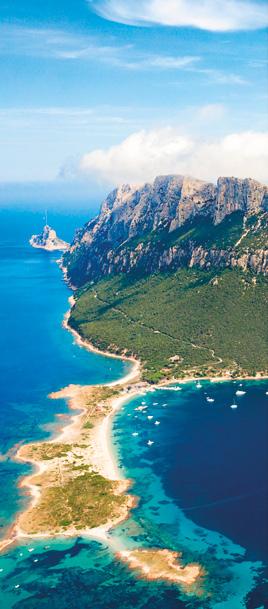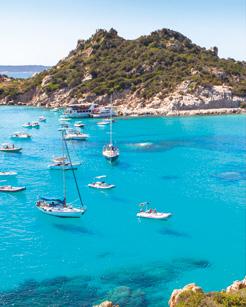
5 minute read
MADDALENA ARCHIPELAGO
This exclusive pocket of Sardinia, in the Strait of Bonifacio, is as though it was made for yachting. Comprising seven main islands and fifty-five ‘isolotti’, Maddalena Archipelago has been a Unesco World Heritage site since 1994, preserving its stunning natural beauty.
With umpteen unspoilt coves, lagoons and beaches to explore, many accessible only by boat, guests are able to play and relax away from prying eyes. Head for Budelli, Razzoli and Santa Maria if it is privacy you seek.
Advertisement
There has been some development of tourism here since the closure of NATO’s naval base on La Maddalena fifteen years ago, though not enough to spoil things for the elite traveller. In fact, thanks to having become accustomed to US naval personnel and their dollars over the decades, service levels are higher here than in many parts of Italy.
Costa Smeralda, named after the emerald colour of its waters, stretches some 50 km from Cannigione in the Golfo di Arzachena, north around Capo Ferro, and south to Cugnana in the Golfo di Cugnana. It is where you come to rub fenders with the highest of rollers.

Porto Cervo
Largely undeveloped, aside from Porto Cervo in the centre and, to a lesser extent, Porto Rotondo, Smeralda is about exclusivity and privacy, in contrast with the brash showing off for which, say, St Tropez or Monaco are renowned. Here, any hard partying —‘bunga bunga’ style or otherwise — mostly takes place on board at anchor, or in private villas, tucked discreetly away inland.
Daytimes are for relaxing on a beach, one more beautiful than the next, and enjoying watersports in the clearest waters. For golf, the course at Pevero Golf Club was designed in 1972 by Robert Trent Jones, rated 4/5 in most golf guides, with the bonus of stunning views.
But if it’s shopping you crave, most of the designer ‘usual suspects’ are found around the marina and in the town. Labels include Bvlgari, Dolce & Gabbana, Versace, Valentino, Prada, Gucci, Tod’s, Louis Vuitton, Roberto Cavalli, Missoni, Trussardi, Rossetti and Cartier. There is even a branch of Harrods and many exclusive lesserknown boutiques where you might get a made-to-measure bikini, or even a tailored jacket for your Chihuahua; a visit to Porto Cervo is a wonderful opportunity to give the black card a good workout.
Dining out
La Maddalena has many lively bars, cafés and trattorias, but for higher-end dining, head back over to the main island.

La Gritta, in Porto Faro, Palau comes highly recommended for fine dining in a garden setting with coastal views. Somu, in Baia Sardinia, comes with a Michelin star and offers creative cooking with plenty of vegetarian and vegan options. Phi Restaurant in Forte Cappellini, Baia Sardinia is a beach nightclub-cum-lounge bar with a renowned mainland chef and a Michelin recommendation. The guide also commends Lu Pisantinu in Porto Cervo and awards a star to neighbouring ConFusion, though customer reviews for both are mixed.
Many yachting visitors don’t venture much beyond Costa Smeralda, though the rest of Sardinia’s east coast offers many more secluded beaches and coves, for those who want to get away from it all.

The coastline is protected from westerly winds, making it perfect for paddle boarding or kayaking. Venturing inland, towns, villages and hamlets are small, rich in folkloric heritage and characteristic, gritty architecture. There are plenty of ancient ruins, typical murals, old churches and small museums that document their colourful history, if visitors can be tempted away from the water.
Land Pursuits
Sardinia’s rugged, sparsely populated interior means great hiking trails and climbs. The Barbagia mountains in the east feature challenging trails for experienced hikers, while on the western side, near Montevecchio are mountainous paths more suited to walkers, offering stunning coastal views, of course.

Its forests meanwhile offer beautiful waterfalls, rock formations and flora to explore. In all instances, it’s advisable to book a local guide, as some of Sardinia’s terrain can be very challenging and unaccompanied explorers regularly require rescuing.

For climbers, Sardinia has some 6,000 sport climbing routes. One of the outstanding favourites is the 148m high Aguglia rock at Cala Goloritzè, a free-standing limestone formation presenting a superb slab climb.
Sardinia has a deep equestrian tradition and offers lots of horse riding possibilities for riders of all abilities, ranging from complex trails to bareback riding on the beach. In the north, the Valledoria area has many paths for experienced riders, while more relaxing trails in the north-east take in the Gallurese coast, with its stunning land- and seascapes. Alongside Sardinia’s population of four million sheep, indigenous wild boar (‘cinghiale’) are abundant, and hunting season is between November and January. A staple of Sardinian cuisine, these wild hogs can weigh up to 100 kg, roaming around the millions of cork oaks, feeding on acorns. Out of season, there are practice hunts that visitors can join. If wanting to combine cruising and shooting, consider coming during September or October.
Hunting is an intrinsic part of selfsufficient Sardinian life and partridge, woodcock, snipe, hare and wild rabbit, lark, pigeon and quail are among the many varieties found. For nonhunters, there are alternative country pursuits such as lake fishing, hiking and clay shooting.
For hunting of a different kind, dense forests here are fertile foraging ground for truffles and mushrooms. Other parts of Italy are larger producers, but varieties such as ovolo, gallinaccio and porcino nero, are abundant here, as well as a range of truffles. In the woods around Laconi, you can join organised forages with dogs, to seek white truffles, though black summer or winter truffles are more common, depending on the time of year.
Diving
With some 1800 km of coastline and crystal clear waters, Sardinia offers some of the very best diving in the Mediterranean. May offers the best visibility, up to 40 metres, but waters are on the cool side before summer. Sardinia offers well lit dives down to 70 metres and a great variety, including caves, corals and crustaceans. Because of the island’s position along busy strategic shipping lanes, surrounding waters are also littered with a variety of wrecks.
Predictably, the north east part of the island is the busiest, with the archipelago of La Maddalena and Bonifacio Strait boasting some forty dive sites. Its granite rocks, drop offs, overhangs, swim-throughs and caves are fertile habitat for a large variety of fish, molluscs and crustaceans. Moray eel, stone fish, bream, conger eel, barracuda, grouper, octopus, crab, lobster and lots of nudibranchs are typical.



Off the northwestern shore, near Alghero, Sardinia’s shoreline caves are replicated underwater. Some of Europe’s largest underwater caves are found at Capo Caccia, in a system of over a hundred caverns in its limestone cliffs. Rare red coral can be found here at only 10 metres.
Nereo’s Cave is the biggest marine cave in the Medi-terranean, featuring a system of arches, tunnels, air chambers and caves deep inside the mountain. Falco’s Cave leads to a dry chamber where divers can take off their gear and look around its stalactites and stalagmites, while the cave is teeming with hermit crabs.

Deer Cave is a partially submerged cavern named after an ancient deer fossil found there, thought to be 100,000 years old.
Olbia
Olbia is regarded as the gateway to northern Sardinia, with the island’s second airport (OLB, LIEO) being closest to Costa Smeralda. It is a popular embarkation point for yachts, with Marina di Olbia just a stone’s throw away.
However, there is more to Olbia than just a transit stop, with a charming old town and pleasant shopping streets leading off Piazza Regina Margherita. There are plenty of boutiques and decent restaurants to while away a few hours in transit, if not a destination in their own right.










